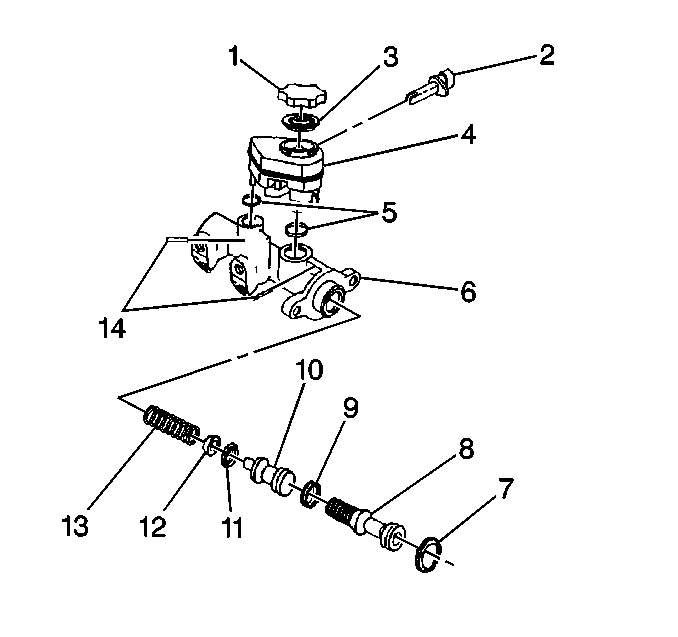Master Cylinder

Important:
• Replace all of the components that are included in the repair
kits used to service this master cylinder. • Lubricate the rubber parts with clean brake fluid in order to
ease assembly. • Do not use lubricated compressed air on the brake parts. This
action may cause damage to the rubber components. • If you remove or disconnect any hydraulic part, you may have to
bleed all or part of the brake system. • The specified torque values are for dry, non-lubricated fasteners. • Perform the service operations on a clean bench that is free from
all mineral oil materials.
This master cylinder is a composite design with a plastic reservoir and an aluminum body. The master cylinder is used in a diagonally split system. In this system, one front and one diagonally rear brake is served by the primary piston (8), and the opposite front and rear brakes are served by the secondary piston (10).
The master cylinder incorporates the functions of a standard dual master cylinder. The master cylinder also has a fluid level sensor (2). The proportioning valves are designed to provide better front-to-rear braking balance with a heavy brake application.
Proportioning Valves
Important: Do not wash the proportioning valve in any cleaning solution. The internal components are prelubricated with a special grease.
(With ABS) The proportioning valves are located in the rear brake lines on each side of the fuel tank. The proportioning valves thread into the rear brake lines. (Without ABS) The proportioning valves are part of the master cylinder. The proportioning valves proportion the brake fluid to each caliper or wheel cylinder after a predetermined amount of pressure is reached. The proportioning valves limit outlet pressure to the rear brakes after the brakes meet a predetermined inlet pressure. The proportioning valves limit pressure when less apply force is needed in order to obtain optimum breaking. The proportioning valves prevent rear wheel lock-up on vehicles that do not have heavy rear wheel loads.
Fluid Level Sensor
The compact master cylinders are equipped with a fluid level sensor. The sensor switch is located in the inboard side of the reservoir. The sensor activates the BRAKE warning lamp if the fluid level is low. The BRAKE warning lamp turns off when the fluid level is corrected.
Antilock Brake System
The antilock brake system uses an amber ANTILOCK lamp.
The lamp is located in the instrument panel cluster. Ensure that the lamp exhibits the following conditions under normal conditions:
| • | The amber ANTILOCK lamp turns ON when the ignition is turned to the RUN position, prior to starting the engine. |
| • | Ensure that the lamp is OFF when the engine starts. The operation of the warning lamp is an important part of the antilock brake system diagnosis. If the warning lamp turns ON when you are driving the vehicle, this indicates a malfunction. |
Substandard or Contaminated Brake Fluid
Caution: Brake fluid may irritate eyes and skin. In case of contact, take the
following actions:
• Eye contact--rinse thoroughly with water. • Skin contact--wash with soap and water. • If ingested--consult a physician immediately.
Caution: Use only Delco Supreme 11, GM P/N 12377967 (Canadian P/N 992667), or equivalent DOT 3 brake fluid from a clean, sealed container. Do not use fluid from an open container that may be contaminated with water. Improper or contaminated fluid could result in damage to components, or loss of braking, with possible injury.
Notice: Avoid spilling brake fluid on any of the vehicle's painted surfaces, wiring, cables, or electric connectors. Brake fluid will damage the paint and the electrical connections. If any fluid is spilled on the vehicle, flush the area to lessen the damage.
Important:
• Do not use power steering fluid or transmission fluid in the brake
system. • Do not re-use brake fluid that has accumulated during the brake
system bleeding. • Store brake fluid in a closed container. Reseal the brake fluid
containers immediately after use. Do not use brake fluid in an open or improperly
sealed container because the fluid absorbs moisture or may become contaminated.
The following conditions may cause the fluid to boil:
| • | Improper brake fluid |
| • | Mineral oil or water in the fluid |
| The rubber components in the brake hydraulic system may also deteriorate. |
If the rubber parts are deteriorated, the following parts will be swollen:
| • | Master cylinder cap diaphragm |
| • | Caliper boots |
Disassemble all of the serviceable hydraulic components if deterioration exists. Wash all of the parts with alcohol. Dry the parts with non-lubricated compressed air in order to keep the alcohol out of the system. Replace all of the rubber parts in the system, including the hoses and the non-serviceable hydraulic components.
Refill the brake system with new brake fluid. Refer to Master Cylinder Reservoir Filling .
Flush the brake system. Refer to Hydraulic Brake System Flushing .
Bleed the brake system. Refer to Hydraulic Brake System Bleeding .
